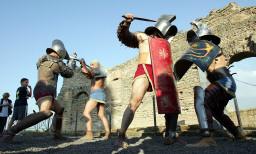Naples is celebrating Campania's sporting heroes of old with a new exhibition devoted to Pompeii and its gladiators.
The exhibit at the National Archaeological Museum is showcasing a host of artefacts uncovered in the town buried by ash and lava during the AD 79 eruption of Mount Vesuvius.
The elaborate pieces are mainly a selection of bronze parade weapons that have recently undergone several years of restoration work, after first being uncovered around three centuries ago inside the theatres of Pompeii.
The items include richly decorated and engraved helmets, greaves, shields, lances and daggers that were once used by gladiators in their battles.
Like some of today's sporting heroes, the gladiators were the target of frenzied adulation.
Pictures and phrases scrawled on the walls of various Pompeian homes and public buildings, mostly from around AD 50 onwards, reveal the devotion they inspired, particularly among female fans.
Gladiatorial games were usually staged in the town's amphitheatre, constructed in 80 BC.
One of the oldest surviving amphitheatres in the world, the Pompeian structure could seat up to 20,000 people and was a massive attraction for both natives and those vacationing in the popular resort town.
A section of the exhibit focuses on the parapet surrounding the arena, which was uncovered during digs of 1748 and 1813.
This was decorated with pictures of battle, victory parades and trophies, testifying to the glory surrounding successful gladiators.
Unlike other shows, the games were not a fixed event on the Roman calendar, so were usually advertised in advance, with notices giving the time and date.
Nearly 75 of these wall paintings have been uncovered in Pompeii, scattered across the entire city and giving a sense of the popularity of gladiatorial battles among all sectors of society.
Entitled Il Gladiatore (The Gladiator), the exhibition is open until December 31 at the National Archaeological Museum of Naples. The same museum is also hosting a parallel show on finds at the nearby site of Herculaneum.









